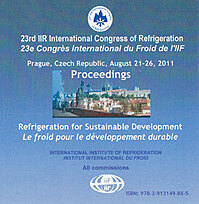
Document IIF
Calculs pour la conception de nouveaux wagons ferroviaires frigorifiques multi-températures.
Design calculation of the new multi-temperature refrigerated railway cars.
Numéro : pap. ID: 258
Auteurs : WANG Y., ZHENG X. Z., ZHU J. Y.
Résumé
Presently, the mechanical refrigerated cars were still staple in the domestic refrigerating transportation, but that existed shortcomings such as the refrigeration equipment was obsolete, the technology was relatively backward and the refrigerating transportation had high energy consumption and costs, etc. According to the condition of the domestic refrigerating transportation, this paper designed a new type of multi-temperature refrigerated railway cars, they had four independent temperature control of cars, the temperature of them were separately controlled in -18 ± 1°C (stored frozen meat, vegetables and other foods), 0 ± 1°C (stored the iced aquatic product such as fresh fishes), 2 ± 1°C (stored fresh fruits and vegetables such as the garlic, potatoes, apples, lynches, etc.),13 ± 1°C (stored the temperature-sensitive fruits and vegetables such as the bell pepper, cucumber, pineapple, bananas, etc.). The refrigerating transportation equipment met the requirements that the low-volume, multi-batch and the different storage environmental request of goods simultaneously refrigerated and transported, so it had a good application prospect in the market.
Documents disponibles
Format PDF
Pages : 8 p.
Disponible
Prix public
20 €
Prix membre*
15 €
* meilleur tarif applicable selon le type d'adhésion (voir le détail des avantages des adhésions individuelles et collectives)
Détails
- Titre original : Design calculation of the new multi-temperature refrigerated railway cars.
- Identifiant de la fiche : 30002331
- Langues : Anglais
- Source : Proceedings of the 23rd IIR International Congress of Refrigeration: Prague, Czech Republic, August 21-26, 2011. Overarching theme: Refrigeration for Sustainable Development.
- Date d'édition : 21/08/2011
Liens
Voir d'autres communications du même compte rendu (569)
Voir le compte rendu de la conférence
Indexation
-
CONCEPTS IN APPLYING LIQUID CO2 REFRIGERATION T...
- Auteurs : GARSIDE D.
- Date : 07/08/1983
- Langues : Anglais
- Source : [Refrigeration serving humanity]. Proceedings of the XVIth international Congress of Refrigeration.
- Formats : PDF
Voir la fiche
-
CRYOGENIC RAILWAY CAR RESEARCH AND DEVELOPMENT ...
- Auteurs : HILL R. P.
- Date : 07/08/1983
- Langues : Anglais
- Source : [Refrigeration serving humanity]. Proceedings of the XVIth international Congress of Refrigeration.
- Formats : PDF
Voir la fiche
-
CARBON DIOXIDE AS AN EXPENDABLE REFRIGERANT FOR...
- Auteurs : BURGENER D. B.
- Date : 17/11/1985
- Langues : Anglais
- Source : Technology advances in refrigerated storage and transport.
- Formats : PDF
Voir la fiche
-
ON THE MEASUREMENT OF REFRIGERATION OUTPUT OF M...
- Auteurs : JIANG N.
- Date : 13/03/1985
- Langues : Anglais
- Source : Long distance refrigerated transport: land and sea.
- Formats : PDF
Voir la fiche
-
CONTROL OF COMPRESSOR REFRIGERATING UNITS FOR L...
- Auteurs : VYKYDAL P., SOUKUP L.
- Date : 07/08/1983
- Langues : Anglais
- Source : [Refrigeration serving humanity]. Proceedings of the XVIth international Congress of Refrigeration.
- Formats : PDF
Voir la fiche
